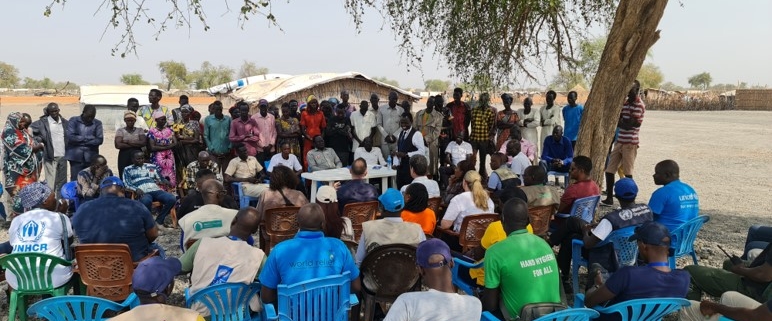This paper aims to shed light on opportunities and challenges of the implementation of the humanitarian, development, and peace (HDP) nexus in South Sudan, and particularly investigating how localisation can be embedded in the HDP nexus in line with a decolonial perspective. This is achieved by identifying the origins of the HDP nexus in South Sudan as a top-down and largely state-centric effort, moving onto a problematisation of the localisation agenda both within UN-led implementations…
repository
CSRF Research Repository
The CSRF Research Repository aims to support greater contextual knowledge for policy makers, programme managers, and implementers by providing a searchable repository of research, analysis, and resources, and providing periodic updates on new research and analysis.
Using the case study of three countries, including South Sudan, this paper explores the extent to which a bottom-up approach has been integrated in the Humanitarian-Development-Peace (HDP) nexus process, particularly from the perspective of humanitarian actors. Specifically, the paper finds that this integration has been challenging mainly due to power imbalance intrinsic to the political positioning of international humanitarian actors. Finally, the paper provides some suggestion how to effectively implement HDP using a bottom-up approach….
This analysis provides a snapshot on the diverse role of chiefs in development, humanitarian, and peacebuilding engagements in South Sudan. It highlights their prominent role in local governance, service delivery, community mobilisation, allocation of resources, etc., and thus showcasing the need for aid actors to better understand their role and interaction with aid provision. Lastly, the analysis piece provides a set of concrete recommendations for aid workers and peacebuilders in the interaction with these actors.
This article explores the integration of peace components in H-D-P nexus programming drawing from qualitative examples across four countries, including South Sudan. Specifically, the article proposes an analysis of how local communities are using integrative peace/conflict approaches to enhance resilience in contexts with ongoing violence. Read here
The ‘Triple Nexus’: Where the humanitarian, development and peace sectors work together to make the most of their comparative advantages to enable a more coherent, efficient and collective response to global challenges. This is an attractive prospect in South Sudan, which continues to experience a range of interconnected crises and shocks that cannot be addressed in isolation. Donors and organisations at all levels therefore proactively engage each other to share information and knowledge, ensure better…
This special issue focuses on the understanding and application of two closely related concepts, “do no harm” (DNH) and “conflict sensitivity”, and their critical engagement in the academic literature. Mary Anderson published her seminal book Do No Harm: How aid can support peace – or war in 1999, which popularised the idea of conflict sensitivity in development, humanitarian, and peacebuilding practice. Since then, many models and tools have been published and considerable efforts have been…
With the increase in protracted humanitarian crises, there is a growing need for more efficient international cooperation between humanitarian, development and peace policy instruments. The Humanitarian-Development-Peace-Nexus (HDP-nexus) approach aims to overcome institutional dividing lines and achieve more coherent collaboration. While various UN initiatives strategically promote the implementation of the HDP-nexus, the UN Country Teams in South Sudan, Cameroon and Kenya in particular have pioneered the operationalization of the nexus. Bottom-up and area-based approaches, among others,…
As climate change increasingly affects the world, much is said about the rising amounts of aid required to support emergency response, long-term development to adapt, and peacebuilding to ensure that conflict does not undermine these efforts. Bringing these ideas together, some advocate for the addition of a separate climate change stream into the humanitarian, development, and peace/peacebuilding nexus (or triple nexus). Based on a critical literature review and synthesis, this article articulates and conceptualizes how…
Often compounding each other, current trends including climate change, environmental degradation, and increased consumption associated with unsustainable development and population growth, present serious threats to human security at global, national, and local levels. These trends are destabilizing economies, negating development gains, exacerbating gender-based violence against women and girls, and undermining global peace and security. This situation is particularly pronounced in countries like South Sudan where women and girls have often borne the brunt of multiple…
Improving collaboration, coordination and learning between humanitarians and peacebuilders is an ongoing challenge. Despite their different approaches, both groups need to rise to this challenge to help achieve their shared goal for the future of South Sudan – that South Sudanese live prosperous, dignified, and secure lives. This paper seeks to provide with a clearer understanding of how, where, and when stronger coordination, collaboration and learning between humanitarians and peacebuilders will more effectively leverage each…

Some Infos
Lorem ipsum dolor sit amet, consectetuer adipiscing elit. Aenean commodo ligula eget dolor.
Pages
- About Our County Profiles
- Blog
- Case Studies Grid
- Central Equatoria
- Conflict Sensitivity Resource Facility South Sudan
- Contact Us
- Contribute a Repository Article
- County Profile HTML links
- County Profiles
- COVID-19 HUB
- Covid-19 information page
- CSRF About Us
- CSRF Helpdesk
- CSRF Helpdesk Form
- CSRF Login
- Dashboard
- Deliverables
- Demo
- Events
- Forgot password
- Guides, Tools and Checklists
- Helpdesk
- Home
- Latest
- Looker Studio
- Subscribe

